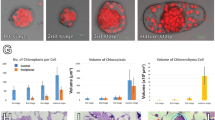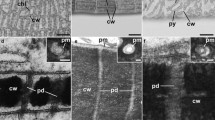Summary
Bulbochaete hiloensis is a filamentous green alga in the Oedogoniales. It possesses colourless hair cells, the ultrastructure and development of which are unusual in several respects:
-
(1)
The initial wall of the hair cell is formed by eversion of a pre-formed pad of cell wall material (Cook, 1962).
-
(2)
The hair cells are apoplastidic, even lacking colourless remnants of plastid material.
-
(3)
A nucleolus is lacking from young and mature hair cell nuclei, though it is not known whether one is present in the earliest stages.
-
(4)
Despite the absence of chloroplasts, starch reserves, and a nucleolus, the ultrastructure of the cytoplasm is characteristic of intensive granulocrine secretory activity. Massed cisternae of rough endoplasmic reticulum and numerous dictyosomes, together with associated transitional and secretory vesicles, are present. Substrate for the biosyntheses in these systems must enter the hairs via plasmodesmata, which exist in the basal wall. The product is probably a mucilage, exported to the exterior through a system of pores which pierce the outer wall of the hair.
-
(5)
Microtubules lie in the hair, and in its bulbous base, where some may be interpreted as having a role in anchoring the nucleus.
-
(6)
The significance of the apoplastidic and anucleolate condition is discussed.
Similar content being viewed by others
References
Brown, D. D.: The nucleolus and synthesis of ribosomal RNA during oogenesis and embryogenesis of Xenopus laevis. In: The nucleolus, its structure and function. National Cancer Res. Inst. Monograph Vol. 23, p. 297–310, eds. W. S. Vincent and O. L. Miller, Jr. Bethesda, Md.: Natl. Cancer Inst. 1966.
Brown, D. D., Gurdon, J. B.: Absence of ribosomal RNA synthesis in the anucleolate mutant of Xenopus laevis. Proc. nat. Acad. Sci. (Wash.) 51, 139–146 (1964).
Conway, K., Trainor, F. R.: Scenedesmus morphology and flotation. J. Phycol. 8, 138–143 (1972).
Cook, P. W.: Growth and reproduction of Bulbochaete hiloensis in unialgal culture. Trans. Amer. micros. Soc. 81, 384–395 (1962).
Esau, K.: The Phloem. Encyclopaedia of plant anatomy, vol. 5, p. 1–496, Berlin: Borntraeger 1969.
Feder, N., O'Brien, T. P.: Plant microtechnique: some principles and new methods. Amer. J. Bot. 55, 123–144 (1968).
Fraser, T. W.: M. Sc. Thesis, The Queen's University, Belfast (1970).
Fraser, T. W., Gunning, B. E. S.: The ultrastructure of plasmodesmata in the filamentous green alga, Bulbochaete hiloensis (Nordst.) Tiffany. Planta (Berl.) 88, 244–254 (1969).
Gibor, A., Granick, S.: The plastid system of normal and bleached Euglena gracilis. J. Protozool. 9, 327–334 (1962).
Grove, S. N., Bracker, C. E.: Protoplasmic organization of hyphal tips among fungi: vesicles and Spitzenkörper. J. Bact. 104, 989–1009 (1970).
Herich, R.: Untersuchungen über die Bedeutung der vegetativen Kerne und ihrer Nukleolen in den Pollenkörnern und Pollenschläuchen. Theoret. Appl. Genet. 39, 62–67 (1969).
Hill, G. J. C., Machlis, L.: An ultrastructural study of vegetative cell division in Oedogonium borisianum. J. Phycol. 4, 261–271 (1968).
Jensen, W. A.: Botanical histochemistry. London, San Francisco: Freeman 1962.
Jensen, W. A., Fisher, D. B.: Cotton embryogenesis: the pollen tube in the stigma and style. Protoplasma (Wien) 69, 215–235 (1970).
Johnson, R., Strehler, B. L.: Loss of genes coding for ribosomal RNA in ageing brain cells. Nature (Lond.) 240, 412–414 (1972).
Kiermayer, O.: The distribution of microtubules in differentiating cells of Micrasterias denticulata Bréb. Planta (Berl.) 83, 223–236 (1968).
Kirk, J. T. O., Tilney-Basset, R. A. E.: The plastids, London, San Francisco: Freeman 1967.
Lott, J. N. A., Harris, G. P., Turner, C. D.: The cell wall of Cosmarium botrytis. J. Phycol. 8, 232–236 (1972).
Moriber, L. G., Hershenov, B., Aaronson, S., Bensky, B.: Teratological structures in Euglena gracilis permanently bleached by exogenous physical and chemical agents. J. Protozool. 10, 80–86 (1963).
Neushul, M., Dahl, A. L.: Zonation in the apical cell of Zonaria. Amer. J. Bot. 59, 393–400 (1972).
Pickett-Heaps, J. D.: The behaviour of the nucleolus during mitosis in plants. Cytobios 2, 69–78 (1970).
Pickett-Heaps, J. D.: “Bristly” cristae in algal mitochondria. Planta (Berl.) 100, 357–359 (1971a).
Pickett-Heaps, J. D.: Reproduction by zoospores in Oedogonium I. Zoosporogenesis. Protoplasma (Wien) 72, 275–314 (1971b).
Pickett-Heaps, J. D.: Reproduction by zoospores in Oedogonium IV. Cell division in the germling and evidence concerning the possible evolution of the wall rings. Protoplasma (Wien) 74, 195–212 (1972).
Pickett-Heaps, J. D., Fowke, L.: Cell division in Oedogonium I. Mitosis, cytokinesis, and cell elongation. Aust. J. biol. Sci. 22, 857–894 (1969).
Pickett-Heaps, J. D., Fowke, L.: Cell division in Oedogonium II. Nuclear division in O. cardiacum. Aust. J. biol. Sci. 23, 71–92 (1970a).
Pickett-Heaps, J. D., Fowke, L.: Cell division in Oedogonium III. Golgi bodies, wall structure, and wall formation in O. cardiacum. Aust. J. biol. Sci. 23, 93–113 (1970b).
Retallack, B., Butler, R. D.: The development and structure of the zoospore vescle in Bulbochaete hiloensis. Arch. Mikrobiol. 72, 223–237 (1970a).
Retallack, B., Butler, R. D.: The development and structure of pyrenoids in Bulbochaete hiloensis. J. Cell Sci. 6, 229–241 (1970b).
Retallack, B., Butler, R. D.: Reproduction in Bulbochaete hiloensis (Nordst.) Tiffany I. Structure of the zoospore. Arch. Mikrobiol. 86, 265–280 (1972).
Tyree, M. T.: The symplast concept. A general theory of symplastic transport according to the thermodynamics of irreversible processes. J. theor. Biol. 26, 181–214 (1970).
Webster, D. A., Hackett, D. P., Park, R. B.: The respiratory chain of colourless algae III. Electron microscopy. J. Ultrastruct. Res. 21, 514–523 (1967).
Woodcock, C. L. F.: The anchoring of nuclei by cytoplasmic microtubules in Acetabularia. J. Cell Sci. 8, 611–621 (1971).
Author information
Authors and Affiliations
Rights and permissions
About this article
Cite this article
Fraser, T.W., Gunning, B.E.S. Ultrastructure of the hairs of the filamentous green alga Bulbochaete hiloensis (Nordst.) Tiffany: an apoplastidic plant cell with a well developed Golgi apparatus. Planta 113, 1–19 (1973). https://doi.org/10.1007/BF00385184
Received:
Issue Date:
DOI: https://doi.org/10.1007/BF00385184




